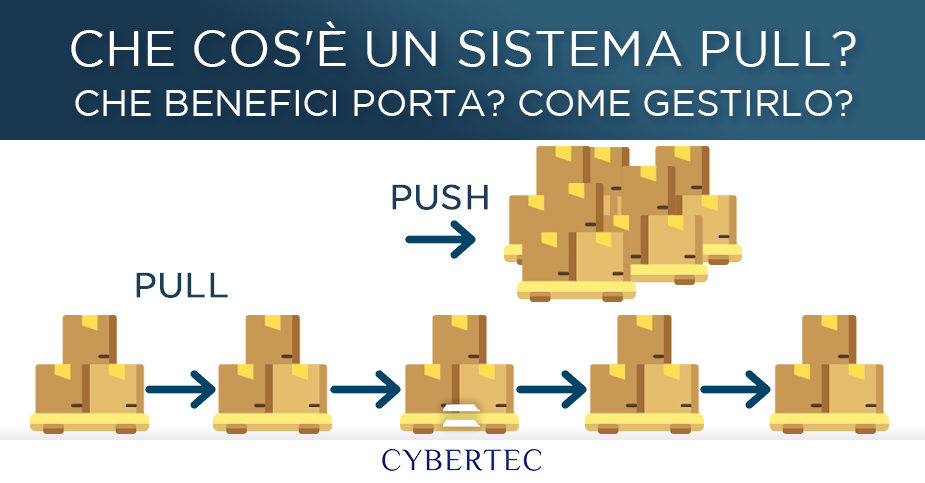Pull-type production systems have emerged from the Lean philosophy and bring benefits to the manufacturing companies that use them. In this article we explain what a pull-type production system is, how to manage it and what benefits companies that use it have.
Whatis a pull-type production system?
That pull is a production logic in which we try to produce exactly what the market requires, both quantitatively and qualitatively. Pull, in fact, means pulling, and therefore refers to producing at the request of the market. In a strictly pull management, the entry of products into production is later than the receipt of orders; production is regulated by what is downstream of the production process. The pull type system is in fact a Lean technique that allows you to reduce the waste of each production process. Applying a pull system allows you to start a new order only after the demand has been communicated and this allows you to reduce surpluses and optimize warehouse costs.
Is a pull system better than a push system?
Pull systems are part of lean production principles, born in the late 1940s. A lean pull system is intended to create a workflow in which work is created only if thereis a request for it.
In essence, the purpose of implementing a pull system is to create products based on actual demand, and not on forecasts. In this way, the company can focus on eliminating waste in the production process. As a result, you will be able to optimize your resources and reduce the possibility of overstocking or overproduction.
In addition, the application of a pull system will allow you to deliver the work just in time. Just-in-time is a production model in which orders are produced to meet actual demands and avoid excessive inventory and push-type strategies.
When applying a push strategy, a company’s output is created based on anticipated demand, which may not match actual demand. Such an imbalance can create unexpected financial gaps.
“Just in Case” productions, on the other hand, are the exact opposite. In these cases, companies try to guarantee excessive production to be ready in case of higher demands in the future.
How to manage a pull production?
Nowadays, the concept of pull system is widely spread in various sectors; in fact, it is used not only in production but also in software development, customer service and more.
In the context of workflow management, a pull system allows workers to pull on their next activity, if they have the ability to start working on it. This can help to better prioritize different tasks and prevent team overload. That way, your team can stay focused on getting the most important work done just in time.
To achieve higher productivity levels and greater workflow efficiency using a pull system, you need to:
Apply pull signals
First of all, you need to establish pull signals. The best way to do this is to create a visual workflow, where all the valuable information can be viewed and tracked. This first step helps to have a complete overview of the production process and to grasp all the important aspects.
Check the system
After building a visual pull system, you need to know how to control it. One of the most common ways to effectively manage your pull system is to limit Work In Progress (WIP). This is one of the fundamental practices of the Kanban method, a very widespread pull system.
For example, on a Kanban board, the workflow is divided into several phases, such as: ready , working, waiting for review, ready for delivery, and so on. By limiting work at each stage, you are able to create a regular workflow and identify the problematic parts in it. Limiting WIP allows you to focus on individual tasks until they are completed. However, limiting work in progress is not enough to build a sustainable pull system: you also have to limit the time that a single item can spend in the system. This limit can vary depending on the size of a task and serves as a requirement. If you forget to do so, some tasks can be time-consuming and reduce flow efficiency.
The benefits of a pull-type production system
Unlike push systems, which force team members to work on multiple tasks (multitasking), a pull system allows team members to focus on a single work item at a time. This approach allows a unit of work to:
- Adapt quickly to changes that may occur in the work process;
- Scale the optimal capacity of your team;
- Deliver work items much faster;
- Reduce waste of resources;
- Increase productivity;
- Improve flow efficiency.
In fact, using the pull principles of Lean makes it possible to improve the forecasts of future work. In fact, pull systems allow you to collect historical data on workflow and average task time. Using this data in combination with different forecasting techniques, such as simulations, provides predictions about how much work can be done in a predefined period of time. In short, the implementation of a pull system is an effective way to optimize the resources of a production process. By applying such a system it is possible to:
- Eliminate wasteful activities;
- Optimize cost efficiency;
- Meet the actual demand;
- Increase productivity and flow efficiency.
Make your supply chain more agile and performing
Make the best decisions based on easy-to-create, easy-to-read scenarios built from secure data and processes. Anticipate competition in reacting to market changes in the best possible way.
Equip your company with a powerful tool that can be used remotely, giving visibility into what is happening to the production chain, from suppliers to delivery to the customer.
Contact our experts for more information.

